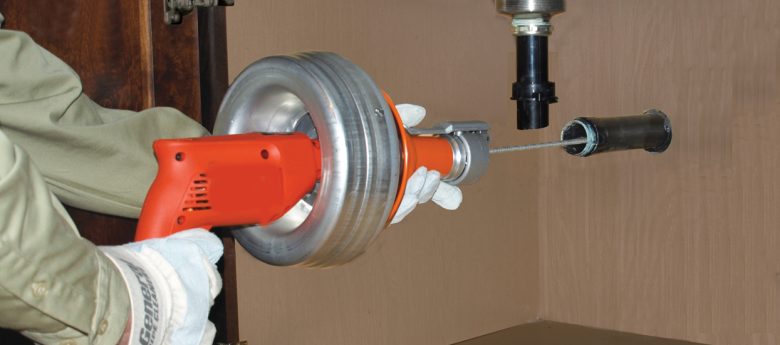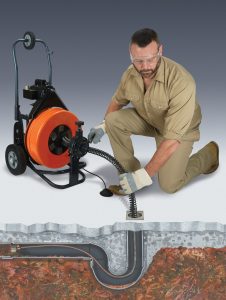Safety and Your Sewer Machine

A horror story:
A contractor tells his assistant to put a drain cleaning machine in a ditch filled with water. The frayed extension cord lies across the wet ground. The assistant, wearing rubber boots, tries to use the machine but complains he is getting shocked. The contractor calls his helper a sissy and gets in the ditch wearing street shoes. When he turns on the machine, he is electrocuted.
Another horror story:
A supervisor has two of his men get in a manhole to guide the cable into the line. The machine sits on the street above with a young apprentice operating the foot pedal. When the cable hits an obstruction, it begins to buck. The men yell to stop the machine but the boy doesn’t. The cable suddenly kinks. One of the men lets out a yell. He has just had two fingers ripped off his hand.
Each of these unfortunate stories could have been avoided. Fortunately, simple, sensible precautions can help plumbing, drain cleaning, and maintenance professionals safely use drain cleaning equipment.
Rule 1. Use common sense.
Commonsense, practical precautions could have prevented both tragedies. So trust your intuition. If you suspect a situation is dangerous, it probably is.
Rule 2. Always monitor surrounding hazards.
Sewer and drain cleaning machines often operate close to water. So make sure that electrical equipment remains safe from current leakage. Routinely check machines, power cords, and extensions for:
- Worn or damaged insulation
- Loose or broken strain relief grommets
- Dangling switches
- Missing ground prongs
Rule 3. Only use equipment with built-in electrical safety devices.
Insist on drain cleaning equipment with Pneumatic Foot Pedals. An air bubble triggers the on-off switch through an air hose. Switching actually occurs at the motor – several feet away. So no electricity runs between the pedal and machine. The operator feeding cable completely controls machine power – not some assistant in the street above.
Each machine should include a Ground Fault Circuit Interrupter (GFCI). GFCIs can detect current leakage as little as 5 milliamps – and automatically shut off power before operators are injured or electrocuted. To protect both machines and wiring, GFCIs should be integrated into power cords – and regularly checked for proper performance.
You can also purchase extension cords with in-line GFCIs. In fact, OSHA requires GFCI’s on extensions used with electrical drain cleaning equipment. And use only heavy-duty extension cords of proper length – no more than 50 feet (15 m). Lighter or longer cords can result in severe power loss and dangerous motor overheating.
Rule 4. Carefully check electrical outlets.
Only plug machines into Properly Grounded Outlets. If in doubt, check outlets with a ground checker before connecting equipment. If you’re using a hand-held drain cleaner with a double insulated motor, make sure the outlet is also Properly Polarized.
Rule 5. Dress for protection.
Only use Leather Gloves when handling drain cleaning snakes. Cloth gloves can easily catch in rotating coils of cable. Avoid loose fitting apparel – and anything that might snag on rotating cable drums. That includes belts, bandanas, and jewelry.

Protect top-to-bottom. Wear safety glasses, goggles, or face shields to guard eyes from flying drain debris and germ-laden splash-back. Long sleeves and work pants minimize bruises and abrasions. And don’t forget rubber footwear around water. Sissies can be smart.
Rule 6. Keep your distance.
Drum-type and sectional machines designed for close-up operation should be securely placed within 2 ft (0.6 m) of a drain opening. If you can’t position equipment that close, run cable through a guide tube or pipe to prevent whipping. Keep all 10 fingers!
Rule 7. Let the machine work for you.
Patience, Grasshopper. Don’t force cable through a blockage. Let the cutter do its work. Otherwise, you risk damaging the snake – and injuring yourself.
If the cable starts bucking or twisting, STOP. Slide the excess snake back into the drum. Then proceed again, slowly feeding cable into the drain. Excessive torque can cause cable to whip and kink, injuring operators.
With a sectional “walk-behind” machine, never touch spinning cable. You could lose a finger. And make sure your machine has a belt guard. That also protects irreplaceable fingers.
Rule 8. Clean-up!
Commonsense cleanliness around wastewater should also be followed. Never touch drain cleaning cables with your bare hands. And thoroughly wash your hands after completing jobs.
Neutralize or remove any corrosive drain cleaners from drains before starting work. Exposure to those chemicals can injure operators – and damage cable.
Rubber gloves alone are never enough. Always wear protective leather gloves over rubber gloves. Spinning cable can easily tear rubber gloves, providing pathways for contaminated wastewater – and possible infection.
Safe cleaning practices help, too. Health care workers apply a solution of 1 part chlorine bleach to 20 parts tap water (1:20) to blood spots on clothing. Your drain cleaning cable and work clothes can be likewise cleaned.
Rule 9. Maintain your equipment.
Make sure your machines are properly maintained. Add Snake-Oil to the cables at the end of each day to prevent rust and extend the life of the cables. And Lubricate bearing regularly as per the instructions. Replace worn parts and cables before a catastrophic failure in the field.
Never leave machines unattended. Turn off and unplug equipment – especially around children and pets. And always read machine instructions. Follow recommended maintenance procedures. And replace worn or lost safety decals.
Rule 10. Use your head, don’t lose it.
No drain cleaning machine is safer than its operator. Plumbing, drain cleaning, and maintenance pros who exercise common sense protect themselves – and their livelihoods!
Drain Cleaning Can Be Messy and Dirty
Fears of disease transmission through wastewater – particularly HIV and HBV (Hepatitis) – remain common concerns. And drain cleaning equipment operators should naturally take sensible steps to safeguard their health.
But a study on HIV and Bloodborne Pathogens (BBP’s) for the Wastewater Industry considers it “unlikely that transmission of HIV could occur in a wastewater treatment setting.”
Still, a number of plumbing contractors are inoculating their workers for Hepatitis B. Building maintenance personnel and municipalities might also consider this.
Tetanus, dysentery, and other maladies pose constant hazards, as well. But simple, prudent precautions can help lower disease risks from wastewater:
- Always wear protective leather gloves over rubber gloves.
- Wear safety glasses, goggles, or face shields.
- Wear long sleeves and pants to cover limbs.
- Thoroughly wash hands after completing jobs.
Common sense in drain cleaning protects health!
Marty Silverman is VP of Marketing at General Pipe Cleaners.
